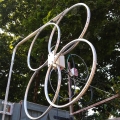n6gn
About
- Username
- n6gn
- Joined
- Visits
- 5,482
- Last Active
- Roles
- Member
- Points
- 31
-
W/F and SND Bad Params
Claire,
The steps I gave before seem to have fixed the problem for me. I am not an expert in this area either but no one has yet commented that there is a better way. To accomplish the block I first logged into my kiwi as root. I did this using secure shell, ssh, on a Linux host but this is also possible from a Windows machine via PuTTy or similar. Using PuTTy, simply enter the address, port 22, and it should then ask you to OK the connection. After you do, it will ask you who you want to log in as. Answer 'root'. That should get you a command line prompt from the kiwi. Once logged in I executed three lines:
iptables -I INPUT -s 47.88.219.24/24 -j DROP
iptables -I INPUT -s 184.22.160.13/24 -j DROP
iptables-save
There may be even easier ways but that's all I did and it seems to have worked, the log is no longer reporting these hits. Presumably these could start again from a different IP address and I would need to repeat one of the above first two commands with that address in place of the one shown.
Glenn n6gn -
Combining/Diplexing Antennas to Single Kiwi
W1EUJ,
I have been working on exactly this for some time. I started with a variety of broadband approaches several years ago. A prototype was published by W6SFH in QST a couple of years ago. I've visited both short dipoles and loops as well as various FET/BJT approaches such as several iterations on the Trask design.
My target has been to get to or very close to the "quiet rural" ITU noise floor with an antenna (system) that can cover the range of the kiwi. It turns out that with small antennas the limiting point is the same as that of the kiwi - upper HF. Although 'radiation resistance' and the associated signal&noise levels are dropping with increasing wavelength, the noise floor at these long wavelengths is rising faster so that allows a very small antenna to work well from LF-midHF. The problem is that to get to the ITU limit above ~14 MHz (or so) one needs to get rather close to KTB. This is not presently possible with available devices. For a dipole, the device that can provide the input Z (low capacity, high R) to avoid mismatch loss can not simultaneously handle the broadband onslaught of highlevel signals and very low noise floor. I have been able to achieve this with an OpAmp design but only VLF up to midHF.
Lately I've been working on a hybrid passive/active approach just as you suggest. But to make this system work with a passive over an [octave] requires some complexity. The Q of a single dipole (around 7) is too high to avoid mismatch loss (see paper by Fano) that raises the effective noise floor. But there are techniques that can do this. For example, a biconical or modified-biconical can be built from wire and give only ~2 dB mismatch loss from 14-30 MHz (and above). It also appears to be possible to couple an active dipole with a passive one to get partial-hybrid, though not over an octave. With a suitable diplexer at, say, 12 MHz, one can combine the best of the active antenna performance with that of the passive and get to a suitably low noise floor.
Presently I'm trying to understand the effects of ground/earth proximity and polarization better. I have kiwis outfitted with both active antennas and multiple V/H passive dipoles (with LNA) available should you like to investigate. The active dipoles are on N6GN/K3 and N6GN/K2 (a remote site) while orthogonal 21 MHz dipoles are at N6GN/K. All three have antenna switches so you can play around, though be cautioned that I'm always messing with things so there's no guarantee what you'll find. I try to keep the Antenna labels current but don't always succeed.
Write me if interested in any particular part of this.
Glenn n6gn -
Seeed Metal case and GPIO connector
-
Seeed Metal case and GPIO connector
Martin,
Thanks for documenting this. From my observations, mainly at HF, the 20-30 MHz noise that is endemic with Kiwis has a vector into the kiwi via CM noise on the LAN connection/lines. I think this is what you were addressing with the CAT5 shield, though it is still possible to get TEM ==> CM conversion on a long cable even with shielding, depending how it is configured. Current injected on the far-end shield can still end up inside the box.
Often this QRN manifests as a family of ~60 kHz separation lines in the 20-30 MHz region. Rob, AI6VN has had good success in mitigating these, without additional enclosure shielding, through use of a USB/WiFi dongle which bypasses the wired LAN connection and attendant spurious energy. Perhaps he will post some documentation of that as well.
Best,
Glenn n6gn -
Anyone using the DX Engineering RF-PRO-1B Active Mag Loop Antenna?
The splash image on http://n6gn.no-ip.org:8073/ has a schematic of a MW band stop that surpresses MW BCB by about 20 dB and allows for one additional notch elsewhere. This may protect a Kiwi from OV while still allowing only slightly reduced access to stations in MW and good access elsewhere. It can be fabricated from inexpensive SMD components. -
Possible to pass arguments to an extension using kiwirecorder?
While " /sys/class/gpio/gpioNN/value" did allow toggling the lines, it seems that it is toggling more than one. I haven't studied the class to understand it and there may be a way around this, however, Gwyn G3ZIL, kindly pointed me to another way that seems to do exactly what I want even more directly. It is:
rsh root@[kiwi IP address] "/root/extensions/ant_switch/frontend/ant-switch-frontend N;" 2>/dev/null
where N is the Antenna N selection desired and 2>/dev/null throws away the return text from the BB resulting from the remote shell call. I expect using this method requires compiling the ant_switch extension into the Kiwi but that is well documented and only takes a few minutes.
This seems to work precisely as hoped and allows setting the GPIO lines of the ant_extension one-at-a-time. I measured 600 ms/setting across my local network.
If someone simply wants a few control lines to use to programatically control an external device on a kiwi - whether an antenna switch or something else - this seems to be a quick, easy and effective way to do it remotely.
I've only tested from a remote computer running Ubuntu Linux but perhaps someone more familiar with Windows can provide an equivalent method for that OS.
See https://github.com/OH1KK/KiwiSDR-antenna-switch-extension/blob/master/docs/antenna-schedules-using-crontab.txt
for automating this with crontab from the kiwi itself. -
MIni Enhancement on the new S meter
Darn, file attach didn't work. Here it is in-line:
#!/bin/bash
### This bash script to sweep a kiwi and report S-meter reading
### steps through the set frequencies
### and stores the results, timestamped, in a file whose name is passed as an argument when calling the script
### Dependencies: Needs kiwiclient directory with kiwirecorder.py
### Version 1.0 May 2019 Script from Gwyn Griffiths G3ZIL hacked for WB7ABP by N6GN
### Version 1.1 throw away initial measurement after frequency (or other?) change. It's bogus. Remove delays
#
#if [$# lt 1]
# then
# echo "no argument"
#fi
#
#3echo "This script needs a single argument, the output file name with a csv extension, e.g. test_22_May_2019.csv"
VERBOSITY=1 # set 1 for test mode, otherwise 0
# say where kiwirecorder is on this host
KR='python /home/ge/kr_test/kiwiclient-master/kiwirecorder.py'
# set the start, stop and increments for the test frequencies, could also be an array e.g. for wspr bands, revisit
START=12000
INC=50
STOP=16000
# quiet ? spots
LIST="60 400 560 600 760 1060 1360 2500 5000 10000 15000 20000 25000 28000 29950"
#LIST={$START..$STOP..$INC}
# one frequency point with 2 averages takes about 1 sec, 10 averages ~2 sec and 100 takes ~20 seconds.
AVERAGES=10
# target KiwiSDR
HOST=10.0.0.77
PORT=8074
# write header to the csv file, with names on one line, units on the other
DATE=`date --utc "+%Y/%m/%d %H:%M"`
echo "Measuring, $HOST, $PORT, on, $DATE" >> $1
echo " Frequency, S Meter" >> $1
echo " kHz, dBm " >> $1
#for i in `seq $START $INC $STOP`
for i in $LIST
do
echo "acquire data for $i kHz"
# set to 10kHz bandwidth
OFF=`$KR -s $HOST -p $PORT -f $i m iq -L -5000 -H 5000 --s-meter 1` # discard, first reading is bogus !!!!
OFF=`$KR -s $HOST -p $PORT -f $i m iq -L -5000 -H 5000 --s-meter $AVERAGES`
# strip off the leading "RSSI:"
Smeter=$(awk -F: '$0=$2' <<<"$OFF")
if [ $VERBOSITY == "1" ]; then
echo "Level was $Smeter dBm"
fi
#
# write data to the file
# get the date and time in UTC
# DATE=`date --utc "+%Y/%m/%d %H:%M"`
# echo "$DATE,$i,$Smeter" >> $1
echo "$i,$Smeter" >> $1
done
echo "Finished sweep"
echo $LIST -
MIni Enhancement on the new S meter
-
Distortion & Noise Measurement of a new KiwiSDR, June 2018
-
Distortion & Noise Measurement of a new KiwiSDR, June 2018










